Recently I’ve been reading Langdon Winner’s wise “The Whale and the Reactor” and David Noble’s great “The Religion of Technology“, books that I can not recommend enough in their own right, but which I only mention here because they led me to the subject of this post. Both Winner and Noble build part of their argument on the work of historian Lynn White, so I was happy to get hold of his “Medieval Religion and Technology”, which is a reprint of the main articles he wrote about the history of technology over the course of his career, from 1940 until 1975. All of these are interesting, quite a few of them are amazing, but there is one article that stood out for me so far, in jaw-dropping fashion; an article called “The iconography of Temperantia and the Virtuousness of Technology”, originally published in “Action and Conviction in Early Modern Europe: essays in Memory of E.H.Harbison”, ed. by Th. K. Rabb and J. E. Seigel, Princeton University Press, 1969.
One of the main reasons Lynn White is cited by Winner and Noble is that he was asking a crucial question in several of his most well-known writings: why did modern technology only really take off in Western Europe and nowhere else ? Ancient Greek, Chinese, Indian, Persian and Arabic civilizations were all at some point culturally much more advanced than medieval Europe, had arguably much better insights in for instance mathematics and astronomy, but the idea of applying science or technology to anything ‘useful’ simply never seemed to arise. One of the examples which has intrigued me for a long time was the steam engine; in a basic form already described by Hero of Alexandria in the first century CE, probably already invented earlier, but not really used until 17 centuries later. Why would anyone care about making natural forces do work ?
In several articles, White makes the case that in the Middle Ages there was a profound change in christian attitudes to technology, to the real world and to work, a change that became most visible in the second half of the 12th century. According to him this directly led to the northern renaissance, hugely influenced the southern, and without it, the development of capitalism and the industrial revolution would have been unthinkable. It is very interesting to read, since I can’t escape the feeling we have now arrived at the other end of this historical curve, where these attitudes to technology, the environment and to work need to be changed in order for our civilisation to survive. But apart from this particular motivation, in White’s “Temperantia” article it is also the images combined with his interpretations that I find are extremely powerful and compelling.
So here a few of the images he discusses (in colour, thanks to the www) and some longish quotes from his article:
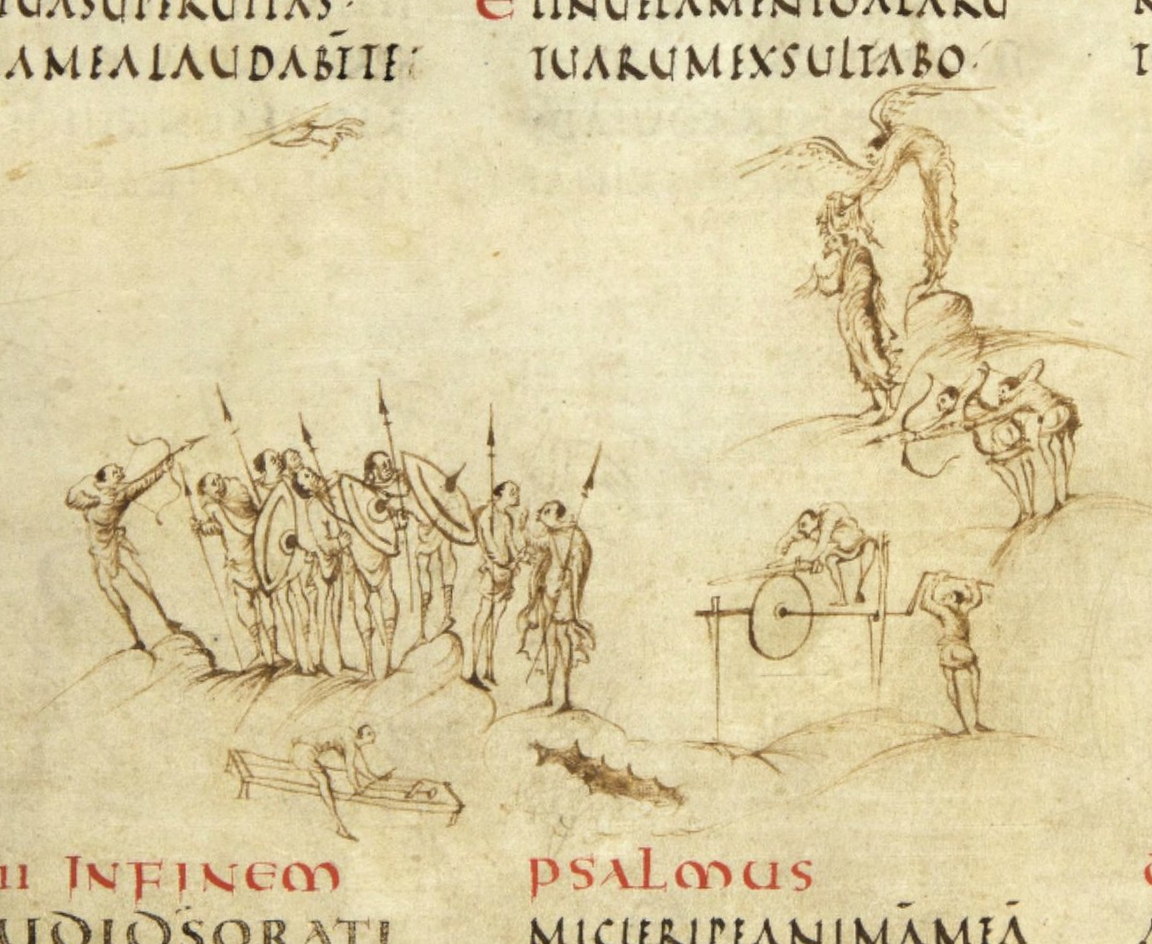
“The first symptom of this tendency to identify advanced technology with high morality appeared in the Utrecht Psalter, illuminated near Rheims between 816 and 834. Bruce Spiegelberg of Colby College has pointed out to me the clear implication of fol. 35v decorating psalm 63. On the right is the Psalmist being blessed by God and protected by an angel and a small band of the righteous. On the left are the evil-doers. … The central interest of the picture lies in the sharpening of a sword in each camp, but by very different means. The iniquitous are content to employ an old-fashioned whetstone. The virtuous, in spectacular contrast, are using the first known example of the rotary grindstone, and it is being turned by the first mechanical crank to appear outside China. Since the substitution of continuous rotary motion for reciprocating motion was basic to the development of machine design, this illumination marks a great moment in the history of technology. But its psychological content is no less portentous than its purely technological import.
Spiegelberg’s exegesis of this ninth-century illumination is entirely coherent with the context of the picture. Between ca. A.D. 400 and 1000 the Frankish regions seized the initiative in technology from the more sophisticated peoples of the Near East and with amazing rapidity developed improved methods in agriculture, in warfare, and in industrial production. The Utrecht Psalter, fol. 35v, expresses in symbols a historical fact of great importance, which contemporaries seem never to have put into words.”
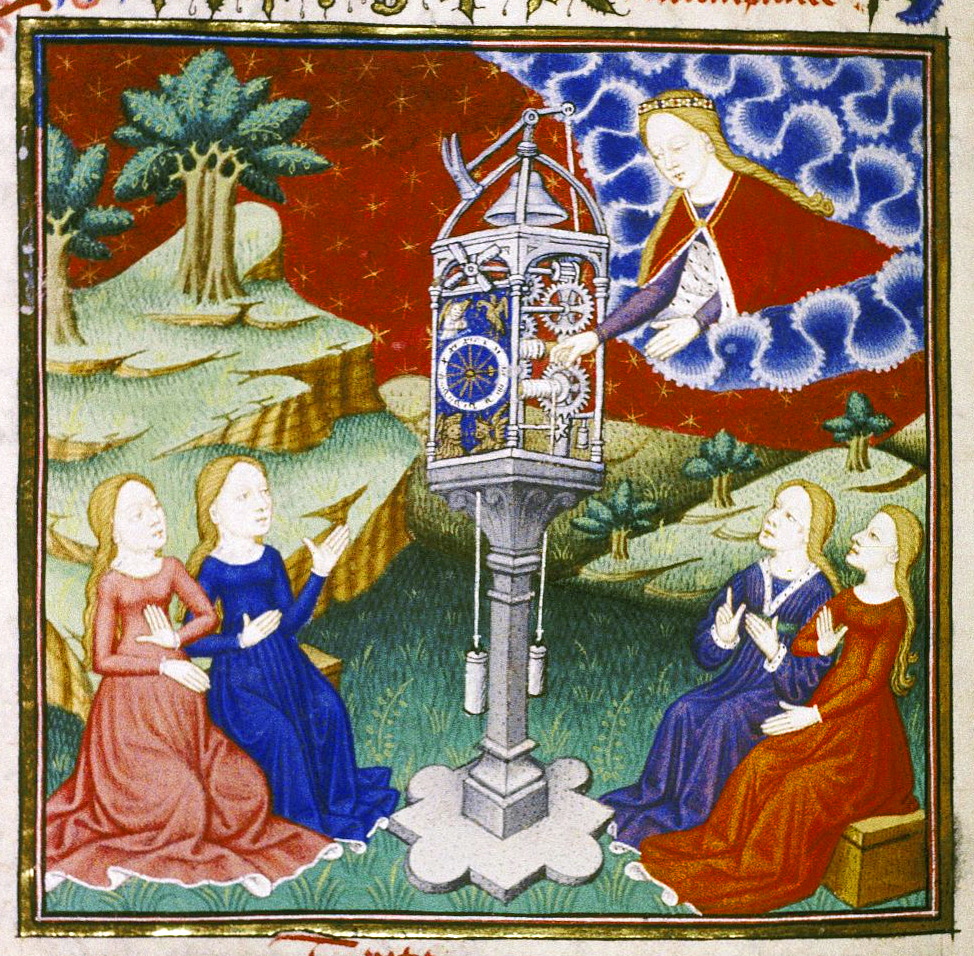
“The Italian idea of representing Temperance with a timepiece was perhaps brought to Northern Europe by one of the Italian artists active in France and Burgundy at the turn of the fifteenth century. On the other hand, it may have been introduced by the father of the Venetian-born Christine de Pisan. About 1400, at the French court, the latter wrote ‘L’epitre d’Othea’, a treastise supposedly sent by the Trojan goddess Othea to a young prince for the formation of his character. Christine tells us that Othea represents ‘the wisdom of woman’ and remarks in a note explaining the pictures that ‘Temperance should be called a goddess likewise. And because our human body is made up of many parts and should be regulated by reason, it may be represented as a clock in which there are several wheels and measures. And just as the clock is worth nothing unless it is regulated, so our human body does not work unless Temperance orders it.’
…
Although Oresme was Dean of Rouen until 1377 and thereafter Bishop of Lisieux, as a favorite of Charles V he visited the court often and produced several works at Charles’s request, including, in 1370, a French translation of Aristotle’s Nicomachean Ethics. Since Thomas de Pisan, likewise a man of scientific interests, was in constant and intimate attendance upon the King from 1368 until 1380, he and Oresme certainly knew each other and exchanged ideas, even though Oresme’s opposition to astrologers mixing in political decisions may at times have chilled their relationship. In his ‘Du Ciel’ Oresme points out that, to explain celestial mechanics and the revolution of the heavenly spheres, the new physical theory of ‘vis impressa’ is insufficient, since without friction the speed of the spheres would accelerate. Thus, to maintain a constant velocity in the heavenly bodies, God, like a divine clockmaker, devised the equivalent of an escapement. Such a concept, by analogy, would strengthen the idea of God’s moral regulation of man inherent in the use of a clock to symbolize Temperantia; macrocosm and human microcosm were always closely associated in medieval minds. One can therefore understand why, about 1400, the originally Italian association of a timepiece with Temperantia began, in Northern France and Burgundy, to emerge as a major expression of religious devotion.”
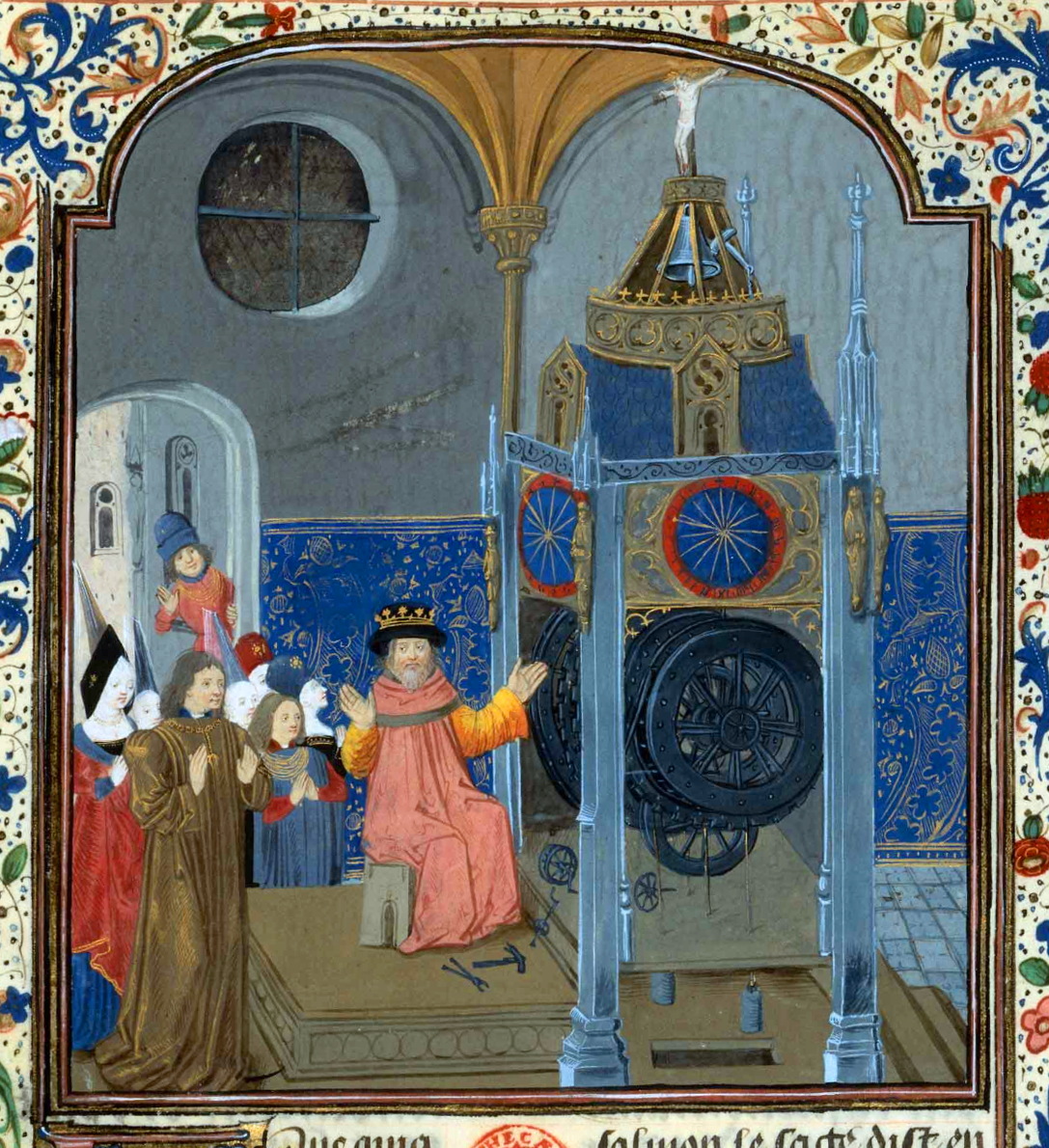
“… The owner of the manuscript, Louis de Bruges, Lord of Gruuthuse, stands at the left. … The earlier allegorical figure of Sapientia-Temperantia has vanished. King Solomon, who is cited in the first lines of the text as praising wisdom and who is traditionally regarded as the historical embodiment of godly wisdom, is repairing a complex clock, the tools of his craft scattered at his feet. One of Louis’s attendants is already at prayer; the Lord of Gruuthuse himself is about to clasp his hands in awed devotion before the clock, to which Solomon is pointing. The mechanism has become the icon of the Christian life.
The substitution of the fleshly-historical Solomon for the allegorical-eternal Temperantia has shifted the religious focus of the picture from Temperantia to the clock itself. But another variation is also significant. In the earlier pictures we see Sapientia-Temperantia reaching into the clock to adjust it. This iconography reflects the period when weight-driven clocks required frequent correction, not only because of mechanical crudities but more especially because the length of the hours of day and night varied constantly with the shift of seasons. In the late fourteenth and early fifteenth centuries, however, the increasing accuracy of clocks led, or enabled, Europe to abandon experiential time for abstract time, the cycle of night and day conceived as twenty-four hours of equal length. Thus, in the manuscript of Louis de Bruges, Solomon is repairing, not regulating the clock. Human life no longer adapts the mechanism to its needs; mankind is in some measure shaped by a machine which it adores.”
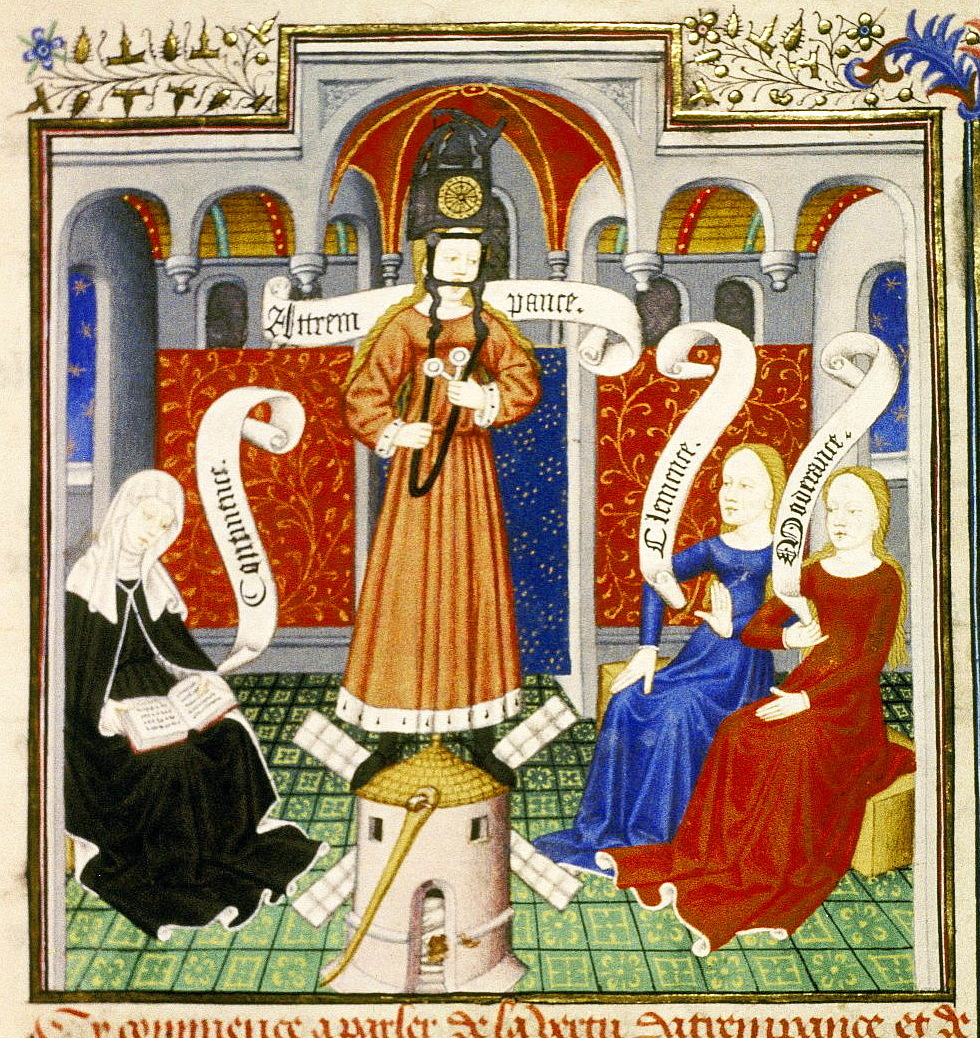
And about these two stunning depictions of Temperantia with a collection of technological attributes (he starts out by writing about the picture of the seven virtues below):
“Two things should be noted about this picture. First, although, in deference to the scholastic doctrine of the ‘unity of species’ of the Virtues, all are shown in the same size, nevertheless in this rigidly symmetrical composition, produced for a hierarchical society, Temperance stands in the center. The meaning is clear: Temperance is the noblest Virtue. Second, the attributes of the other six Virtues subordinate to Temperance are notably less technological and less recent than hers. Indeed, their equipment would have been entirely familar to a Roman: Faith holds a codex; Hope has bee hive, spade and sickels, stands on a bird cage, and wears a ship on her head; Charity stands on a furnace; Justice has her ancient swords and balance; Prudence holds a mirror and sieve; Courage wears an anvil on her hear and stands on a screw press, a Hellenistic invention but the most recent bedecking any Virtue other than Temperance, except for the codex, which is first mentioned by Martial.
In remarkable contrast, except for the bit, whose origin dates back at least to the second millennium before Christ, all the attributes of Temperance are much more recent. Whereas prick spurs are ancient Celtic, the rowel spurs shown in puctures of Temperantia originated in the late thirteenth century. Eyeglasses were invented in the Pisa-Lucca region in the 1280’s. The mechanical clock was developed in the second quarter of the fourteenth century, in the years when Suso was composing his Horologium Sapientiae. Although the windmill appeared in the 1180’s as a small post-mill, the massive masonry tower-mill shown in our Temperantia pictures, in which only the conical top rotates to keep the vanes into the wind, was very recent when this iconographic scheme was contrived: the tower-mill is first found in a miniature of the end of the fourtheenth century. Four of the five technological items in the new iconography of Temperance were thus relatively novel when the schema was invented slightly before 1450.
What is the meaning of this development ? As has been said, the texts to which these illuminations are attached tell us little. But the images themselves speak clearly. Temperance, once the least esteemed of the Cardinal Virtues, had risen during the thirteenth and fourteenth centuries to the status of the preeminent Virtue, equated with Divine Wisdom and the Second Person of the Trinity. Her essential character had become Measure, and, since we mortals dwell in time rather than eternity, her prime symbol came to be the clock. But then, toward the middle of the fifteenth century, Northern Europe clothed this supreme Virtue not simply with the clock but with the new technology of the later Middle Ages: on her head she wore the most complex mechanism of the era; her feet now rested on the most spectacular power engine of that generation; in her hands she held eyeglasses, the greatest recent boon to the mature literate man. The new icon of Temperance tells us that in Europe, below the level of verbal expression, machinery, mechanical power, and salutary devices were taking on an aura of ‘virtuousness’ such as they have never enjoyed in any culture save the Western. About 1450 the novel productive system of Europe, based on natural power, mechanization, and labor-saving invention, which has been the backbone of capitalism, received the sanction of religious emotion and moral sensibility.”
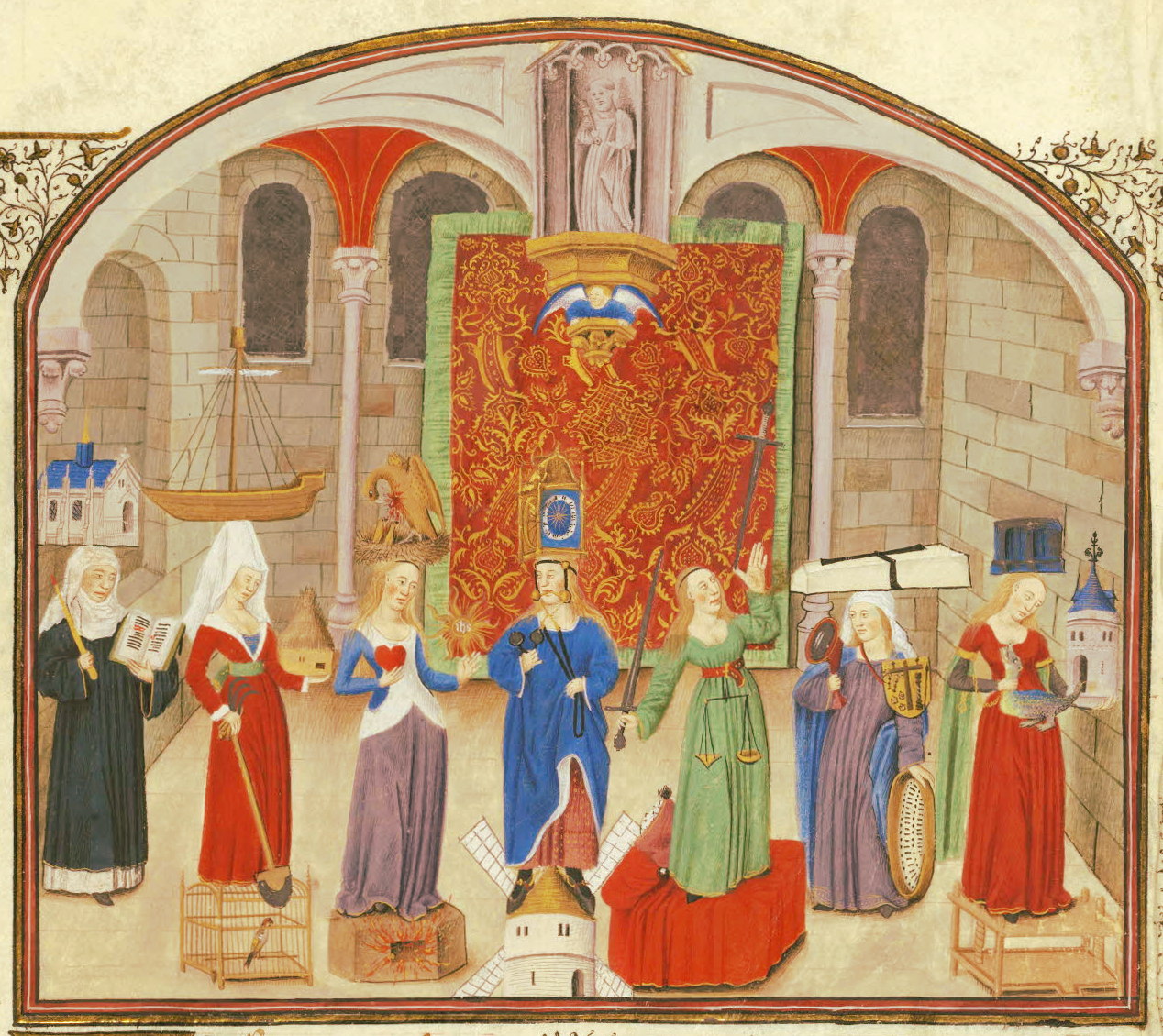
This article is only one of several in which Lynn White formulates a partial answer to the question why modern science and technology arose in Western Europe, but his discussion of these images struck many chords with me. The use of the mechanical clock as a metaphor of the human body, so soon after its invention, of course resonates strongly with the now widespread idea that a human, the mind, or even the universe resembles a computer. What is new, except that in this case the analogy was actually still fresh and powerful and not a worn-out and narrow-minded trope. But especially his early link between technology and ideas about (auto-)regulation of humans is food for further thought; It reminds of Foucault’s “Surveiller et punir” and his history of technologies of discipline. Also it rhymes with Sloterdijk’s anthropotechnics, and his thesis that all culture is a form of human domestication. In any case the image of Temperantia charged with technological attributes including a bit and bridle will stick in the mind for some time to come.
